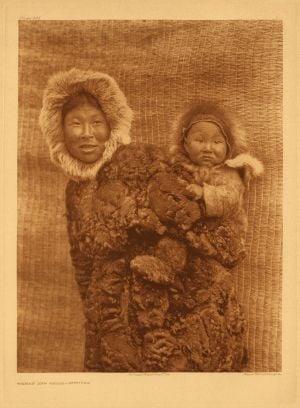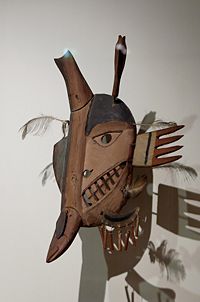Difference between revisions of "Yupik" - New World Encyclopedia
Rosie Tanabe (talk | contribs) (ready) |
m (Robot: Remove claimed tag) |
||
| Line 1: | Line 1: | ||
| − | + | {{Ready}} | |
[[Category:Politics and social sciences]] | [[Category:Politics and social sciences]] | ||
[[Category:Anthropology]] | [[Category:Anthropology]] | ||
Revision as of 19:28, 2 April 2008
The Yupik or, in the Central Alaskan Yup'ik language, Yup'ik, are a group of indigenous or aboriginal peoples of western, southwestern, and southcentral Alaska and the Russian Far East. They include the Central Alaskan Yup'ik people of the Yukon-Kuskokwim delta, the Kuskokwim River, and coastal Bristol Bay in Alaska; the Alutiiq (or Suqpiaq) of the Alaska Peninsula and coastal and island areas of southcentral Alaska; and the Siberian Yupik of the Russian Far East and St. Lawrence Island in western Alaska. They are Eskimo and are related to the Inuit.
The Central Alaskan Yup'ik are by far the most numerous group of Yupik. The Central Alaskan Yup'ik who live on Nunivak Island call themselves Cup'ig (plural Cup'it). Those who live in the village of Chevak call themselves Cup'ik (plural Cup'it).
Culture
Traditionally, families spent the spring and summer at fish camp, then joined with others at village sites for the winter. Many families still harvest the traditional subsistence resources, especially salmon and seal.
The men's communal house, the qasgiq, was the community center for ceremonies and festivals which included singing, dancing, and storytelling.example The qasgiq was used mainly in the winter months, because people would travel in family groups following food sources throughout the spring, summer, and fall months. Aside from ceremonies and festivals, it was also where the men taught the young boys survival and hunting skills, as well as other life lessons. The young boys were also taught how to make tools and qayaqs (kayaks) during the winter months in the qasqig. There is also a shaman involved in the ceremonies.
The women's house, the ena, was traditionally right next door, and in some areas they were connected by a tunnel. Women taught the young girls how to sew, cook, and weave. Boys would live with their mothers until they were about five years old, then they would live in the qasgiq. Each winter, from anywhere between three to six weeks, the young boys and young girls would switch, with the men teaching the girls survival and hunting skills and toolmaking and the women teaching the boys how to sew and cook.
Yup'ik group dances are often with individuals staying stationary, with all the movement done with rhythmic upper body and arm movements accentuated with hand held dance fans very similar to Cherokee dance fans. The limited movement area by no means limits the expressiveness of the dances, which cover the whole range from graceful flowing to energetically lively to wryly humorous.
The Yup'ik are unique among native peoples of the Americas in that children are named after the last person in the community to have died, whether that name be a boy or girl name.
Languages
The five Yupik languages (related to Inuktitut) are still very widely spoken, with more than 75% of the Yupik/Yup'ik population fluent in the language.
The Alaskan and Siberian Yupik, like the Alaskan Inupiat, adopted the system of writing developed by Moravian missionaries during the 1760s in Greenland. The Alaskan Yupik and Inupiat are the only Northern indigenous peoples to have developed their own system of hieroglyphics, a system that died with its inventors.[1]
Through a confusion among Russian explorers in the 1800s, the Yupik people bordering the territory of the unrelated Aleuts were erroneously called Aleuts, or Alutiiq, in Yupik. This term has remained in use to the present day, along with another term, Sugpiaq, which both refer to the Yupik of Southcentral Alaska and Kodiak.
See
of Yupik languages. The whole Eskimo-Aleut family, and also all Alaskan languages are shown. Available online [2]. Here is a wikified version of the mentioned tree (restricted to the Eskimo-Aleut family):
- Eskimo-Aleut
Some differences may exist in the terminolgy or in the details of the classification, in comparison to the main article.
Notes
All Links Retrieved December 15, 2007.
- ↑ "The Inuktitut Language" in Project Naming, the identification of Inuit portrayed in photographic collections at Library and Archives Canada
- ↑ Alaska Native Language Center
ReferencesISBN links support NWE through referral fees
- Campbell, Lyle. 1997. American Indian languages: The historical linguistics of Native America. New York: Oxford University Press. ISBN 0-19-509427-1
- de Reuse, Willem J. 1994. Siberian Yupik Eskimo: The language and its contacts with Chukchi. Studies in indigenous languages of the Americas. Salt Lake City: University of Utah Press. ISBN 0-87480-397-7
- Mithun, Marianne. 1999. The languages of Native North America. Cambridge: Cambridge University Press. ISBN 0-521-29875-X
External links
- Alaska Native Language Center Retrieved December 15, 2007.
- Project Naming, the identification of Inuit portrayed in photographic collections at Library and Archives Canada. Retrieved December 15, 2007.
Credits
New World Encyclopedia writers and editors rewrote and completed the Wikipedia article in accordance with New World Encyclopedia standards. This article abides by terms of the Creative Commons CC-by-sa 3.0 License (CC-by-sa), which may be used and disseminated with proper attribution. Credit is due under the terms of this license that can reference both the New World Encyclopedia contributors and the selfless volunteer contributors of the Wikimedia Foundation. To cite this article click here for a list of acceptable citing formats.The history of earlier contributions by wikipedians is accessible to researchers here:
The history of this article since it was imported to New World Encyclopedia:
Note: Some restrictions may apply to use of individual images which are separately licensed.

